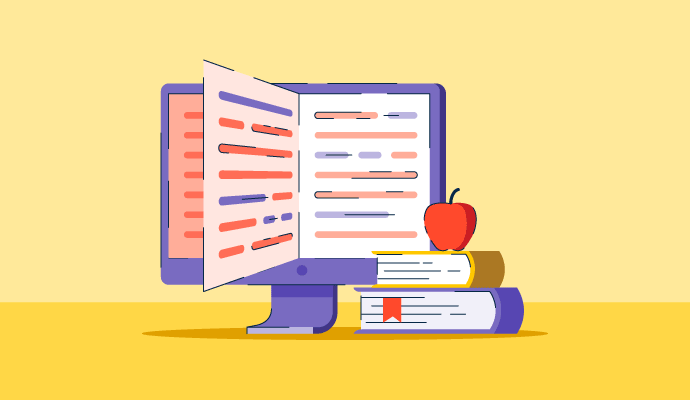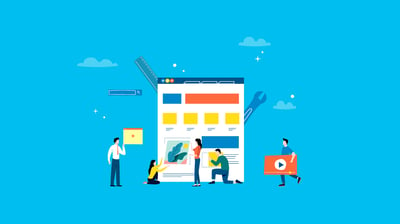January 24, 2024
 by Holly Landis / January 24, 2024
by Holly Landis / January 24, 2024

Technology has drastically changed the world of work over the last two decades, but the educational world has, for the most part, been relatively slow to adapt.
That’s all beginning to shift thanks to the introduction of learning management systems (LMSs). These tools have made moving toward online learning much simpler, creating a more connected and accessible experience for students in any location.
Learned management system (LMS) training gives instructors, administrators, and students information that helps them teach or learn. In an educational setting, this is most likely the contents of an academic course, where the LMS is used to manage and provide online course materials, assignments, and assessments.
Most educational institutions use learning management systems that are specifically formulated for academia with features that aid in a classroom setting for both in-person and virtual learning. Students can access learning material, assignments, and grades within the LMS, while instructors can add any important information or send communication.
Every LMS looks different, even if they have many of the same features. They’re typically broken down into one of four types based on audience or how they’re hosted.
The main features of an LMS are accessible for almost all users, but there are some specific options only available to admins or instructors, while others are accessible to students. Below are some examples of how these features are segmented by user role.
Most accessible m features relate to course content and the ability to interact with students and instructors. Users log in to the LMS to visit their dashboards where they can see all of their classes for that semester or quarter.
From there, students can navigate the user interface to individual classes and see features like:
The dashboard may also have features like a calendar that integrates data from multiple courses, an inbox for private messaging with instructors, and account information where the student can update their contact details.
On the administrative side of the LMS, instructors should have access to the same features that students have, in addition to admin-specific functionality for assistance with course management.
Some of the extra features that instructors and institutional administrators can see in the LMS may include:
For many educators, LMS training is an integral part of the modern learning experience. that These platforms bring plenty of benefits to students and instructors.
of faculty strongly agree that LMSs are critical tools for enhancing student learning.
Source: EduCause
Having all course documentation in one place makes it much easier to find files and assignments. There’s no more excuses from students that they couldn’t find a link in an email, or they weren’t able to submit an assignment because their printer stopped working.
Instead, everyone has access to the same information in one centralized location. Students have unlimited access to training materials and courses can be taken
over and over again, creating less work for instructors when rolling out programs each semester. Many tasks can also be automated once documentation is added to the system, which frees up even more time for teaching staff.
Keeping track of how each student in the class is doing can now happen in real time with an LMS. If assignments are late or missing, the LMS provides a digital footprint for this information. The same is true for attendance in live classes – a manual register no longer needs to be taken if instructors can see who’s logged in via their LMS account.
Admins and students can now automatically generate performance reports to keep tabs on grades and progress throughout the semester. This makes it easier for instructors to address concerns about struggling students as soon as they notice a problem. This can greatly improve students’ chances to make corrections for a successful outcome at the end of the course.
Travel, parking, printed materials and textbooks, even heating and air conditioning costs can all be eliminated, or at least significantly reduced, in online learning environments. Both instructors and students can access their classes at any time so additional funding is freed up for other initiatives like campus improvements or hiring new staff.
Educational compliance rules change often, especially as they relate to digital data and technology. Using an LMS means admins can update training materials to remain within compliance quickly and easily. This helps educational institutions avoid costly penalties if they’re ever noncompliant.
Professors obviously can’t be in two places at once to teach two completely different groups of students at the same time. Or can they?
When instructors create course materials that students can use at any time, there’s more opportunity to create additional classes. Pre-recorded class videos and accompanying assignments can be uploaded into the LMS. Removing the need for in-person or live classes means that instructors can now teach an endless number of students at any time.
A good LMS platform should provide instructors with a single piece of software that makes online learning accessible to any student, while optimizing the educational experience.
To be included in the learning management systems category, platforms must:
* Below are the top 5 leading learning management system platforms from G2’s Winter 2024 Grid® Report. Some reviews may be edited for clarity.
Google Classroom is a Google Apps for Education tool that allows teachers to create virtual classrooms. Features include assignment scheduling, quizzes and tests, feedback, and direct communication within the platform.
“I've been using Google Classroom since the pandemic. What I like about Google Classroom is the interface. When I enroll in a subject, it automatically appears in the application. It is really a student-friendly platform.”
- Google Classroom Review, Pangilinan E.
“I dislike that if I create an assignment and post it to one classroom I can't go back and repost it easily to another class.”
- Google Classroom Review, Mary Beth B.
Canvas is a cloud-based learning management system that you can tailor to any size and type of education institution, from K-12 to universities and colleges.
“Canvas is a robust LMS that our students in Grades 6 through 12 use on a daily basis. The ability for Canvas to pass grades back to our Student Information System and use Learning Tools Interoperability (LTI) plugin to connect to other products, such as EdPuzzle and our curriculum online textbooks, makes it an invaluable tool for our educators.”
- Canvas Review, Mandy L.
“There is a learning curve. I had to watch some videos to learn about a lot of the different features since I didn't have anyone to specifically teach me, so it can be overwhelming at times. You definitely have to put the work in to learn the basic functions, which some people are not willing to do.”
- Canvas Review, Jessica D.
D2L Brightspace provides a flexible learning platform that can be personalized based on the institution or company’s needs. From schools and universities to corporations and nonprofits, the platform comes with training capabilities that simplify educational management.
“It makes online teaching convenient and fun. I liked that it offers useful functions and shows documentation on how to use it and it is all very well organized. It's also great to be able to evaluate notes with ease of access.”
- D2L Brightspace Review, Lola R.
“Many of the tools that D2L Brightspace offers, such as the accessibility checker, can be difficult to find, especially for faculty who are learning how to use it. Incorporating different grading systems (points-based vs weight-based) is not as easy as it should be.”
- D2L Brightspace Review, Ryan K.
An enterprise-level learning management system, Docebo helps both businesses and educational institutions provide a simple and refined approach to training. Features include course management, enrollee reporting, communication systems, and learning progress tracking.
“I use Docebo Learn on a daily basis and I find it to be an intuitive LMS, easy to learn and manage while still being very customizable.There are various plugins and additions that complement the wide variety of options already included in the tool to implement with your organization's suite.The support structure is excellent with an easy-to-reach help desk. Our direct customer contact is always easily available.”
- Docebo Review, Graeme E.
“While they are working hard to introduce new features and functionalities, there are some that the platform lacks that I know clients have been requesting for a while, such as users being able to download their own training records.”
- Docebo Review, Annarose P.
360Learning is an LMS platform that assists collaborative learning for both corporations and educational facilities.
“The ease of creating training content with varied pedagogical methods, the ability to engage learners effectively, the ergonomics and aesthetics of the tool, coupled with efficient statistical tracking.”
- 360Learning Review, Anthony M.
“At times finding answers in the knowledge base is challenging if you don't phrase searches the way 360 does.”
- 360Learning Review, Cathy B.
By investing in LMS training, your instructors gain time to dedicate to their students and their unique experiences within the courses they teach. Thanks to the simple approach these platforms bring, it’s no wonder that instructors and students love the freedom and flexibility of an LMS.
Learn more about how the COVID-19 pandemic changed the way we think about online learning and how LMS software made it all possible.
Holly Landis is a freelance writer for G2. She also specializes in being a digital marketing consultant, focusing in on-page SEO, copy, and content writing. She works with SMEs and creative businesses that want to be more intentional with their digital strategies and grow organically on channels they own. As a Brit now living in the USA, you'll usually find her drinking copious amounts of tea in her cherished Anne Boleyn mug while watching endless reruns of Parks and Rec.
It’s never too late to learn something new.
 by Mara Calvello
by Mara Calvello
“An investment in knowledge pays the best interest.” — Benjamin Franklin
 by Courtney Moran
by Courtney Moran
So, you’ve decided to implement a new corporate LMS.
 by Aris Apostolopoulos
by Aris Apostolopoulos
It’s never too late to learn something new.
 by Mara Calvello
by Mara Calvello
“An investment in knowledge pays the best interest.” — Benjamin Franklin
 by Courtney Moran
by Courtney Moran


